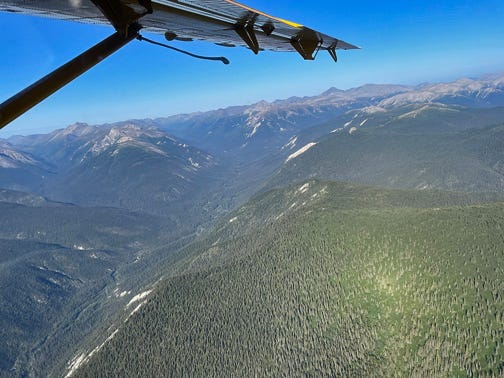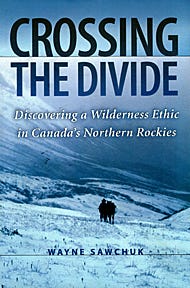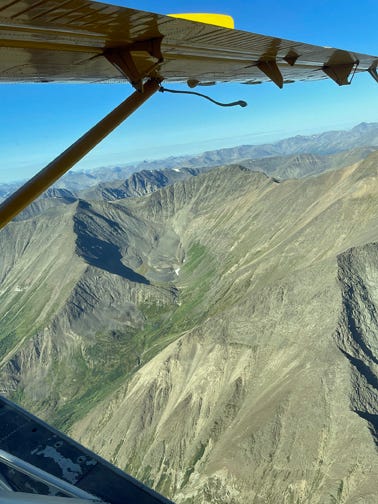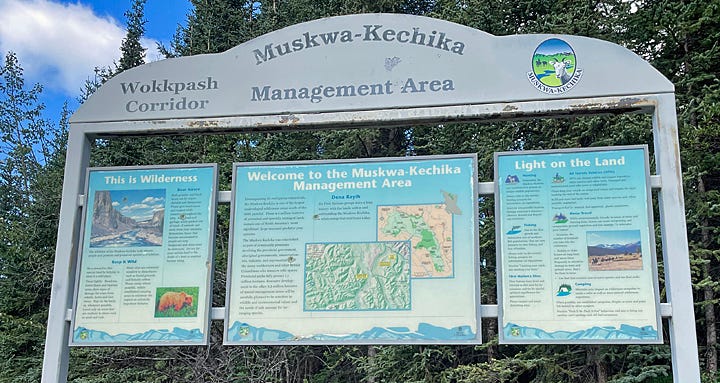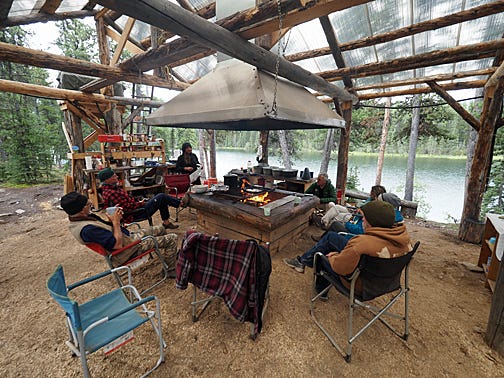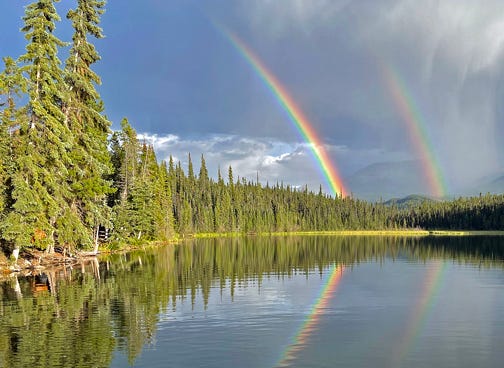The deep blue water of Muncho Lake dropped away from us as we steeply climbed to get above the approaching mountains. Soon bare mountain ridges and broad forested valleys, bisected by meandering wild rivers, passed below us. No roads, highways, powerlines or pipelines were visible as far as the eye could see. Wilderness in the true sense of the word.
If you’ve driven the Alaska Highway from Dawson Creek, British Columbia to Delta Junction, Alaska, you know it’s one of the most spectacular road trips you can take in North America, passing through some amazing wild mountainous country. Betty and I have driven the highway many times, once to Alaska and several times to the Yukon. Along the portion of the highway through British Columbia, I always marvelled at what appeared to be untouched wild country we were passing though, specifically north of Ft. Nelson to the Yukon border. Few other roads were apparent on a map. Being interested in wilderness since I was old enough to shoulder a backpack, I wondered just how one might experience that country…?
I never really pursued an answer to that question until a couple of years ago when a friend of mine sent me a copy of Wayne Sawchuk’s book Crossing the Divide, Discovering a Wilderness Ethic in Canada’s Northern Rockies (2020). My friend is a fellow biologist who shares my passion for wild places and felt I should read this story about a former logger turned conservationist who made it his mission to protect one of the last wilderness areas in North America, the Muskwa-Kechika in Northeast British Columbia.
The Muskwa-Kechika Management Area (M-KMA) was established by an act of the British Columbia Legislature in 1998 after a long process of negotiation among the people with an interest in the area. It is 64,000 km2 (24,700 mi.2) in size, about twice the size of Vancouver Island. The area is named after two large rivers, the Muskwa and Kechika that traverse the land. The M-KMA stretches over a large chunk of the Northern Rocky and Cassiar Mountains (see the BC Government M-KMA location map) and spans 50 watersheds that support a diverse ecosystem that include many large mammals such as stone sheep, mountain goats, caribou, moose, elk, grizzly and black bears, wolf and cougar, as well as a variety of smaller mammals, birds and fish.
The M-KMA is comprised of a unique combination of Resource Management Zones that protect certain regions for their conservation and cultural values and other regions where limited development can occur but in support of wilderness values (a PDF map of the Resource Management Zones is available here).
· The heart of the M-MKA is the 18 Protected Areas, which are ecological reserves and provincial parks, managed by BC Parks. They are strategically placed to safeguard certain wildlife, landscape, natural, recreational or cultural values.
· Complementing the Protected Areas are the seven Special Wildland Zones, where the management emphasis is on “ecological conservation, wilderness, and commercial and non-commercial back-country recreation.”
· Twenty Special Resource Management Zones cover the majority of the M-KMA. In these the management emphasis is on commercial recreation and other non-extractive activities that preserve the natural values in the zones. These areas are also important wildlife corridors between the Special Wildland and Protected Area Zones.
· Two Enhanced Resource Management Zones encompass developed areas that include heavy-use industrial and commercial activities. The two zones in the M-KMA are the Alaska Highway Corridor, where recreation and tourism resources are enhanced, and the Khak'i Tse (Buffalohead) zone, where timber harvesting and mineral extraction are allowed, except where they conflict with special values of First Nations, fish, wildlife and habitat.
Simple, huh?
As you can see the Muskwa-Kechika is not a simple wilderness area. It is a complex of areas with a variety of protective regimes. This complexity reflects the diversity of interests in the area apparent in the early 1990s when Wayne Sawchuk was looking at maps of undeveloped watersheds in the Northern Rockies that might hold potential for wilderness protection. He was not alone. George Smith of the Canadian Parks and Wilderness Society (CPAWS) was also looking for such areas as both men understood that more wilderness needs to be protected to ensure as much biodiversity as possible survives the demands of Canada’s increasing human population.
But conservationists were not the only ones interested in this territory. Forestry and mining industries, hunting outfitters and First Nations were among those who voiced their concerns as to how the land should be used. The difficulty for Sawchuk and Smith was getting representatives of all these interests into the same room at the same time. While George Smith used his skills to gather funding and guide the project through the politics, Wayne Sawchuck used his negotiating skills and intimate knowledge of the landscape to convince all parties that the Muskwa-Kechika wilderness was worth protecting. Their hard work and dedication, along with that of many others, led to a remarkable wilderness area that is a model for how wilderness areas can be protected for the benefit of future generations.
Access
So, how do you get into this wilderness? Unlike more-developed wilderness areas and parks, you won’t find many maintained trails into the Muskwa-Kechika and fewer roads. Access to most of the area is by air or rivers. Tourists experience the area along the Alaska Highway Corridor in such places as Muncho Lake and Liard Hot Springs, where commercial accommodations and designated campgrounds are available.
Other non-maintained gravel roads and trails, such as the Wokkpash Corridor (PDF map), provide limited access but no formal campgrounds. Primitive camping is permitted but campers should minimize their impact on the land by using the sites of previous campers and practicing “pack it in—pack it out.”
All-terrain vehicles (ATVs) are permitted only on designated trails to reduce disturbance to wildlife. Hiking and backpacking are limited by lack of maintained trails and difficult rivers to cross. Knowing how to navigate in wilderness, using orienteering skills, is necessary.
One of the best ways to see the Muskwa-Kechika is via horseback. Horses can cover longer distances in a day and more easily cross rivers. They also carry camping gear and supplies. Needless to say, equestrian experience is helpful.
The best way to experience the Muskwa-Kechika is with an experienced guide and outfitter. There are several outfitting companies offering such guided trips (google “Muskwa-Kechika outfitters”). Many are hunting outfitter-guides, but a few offer trips for people who don’t wish to hunt but want to experience the country and wildlife. One such company is Wayne Sawchuk’s Muskwa-Kechika Adventures. He offers a variety of horse-riding trips into some of the major valleys and alpine regions. These are long expeditions of several days’ duration, camping along the way and seeing a lot of country. Others are Wilderness Retreats at his Mayfield Lake camp in the Gataga River Valley of Dune Ze Keyih Provincial Park. The retreats offer full wilderness emersion with optional hikes, canoeing and day rides on horseback.
Betty and I joined one of Wayne’s wilderness retreats in August of 2023. Although we had some horseback riding experience, being in our 70s and recovering from a severe bout of Covid-19 earlier that year, our physical fitness wasn’t up to mounting a horse and spending a long time in the saddle. So, the wilderness retreat was a perfect fit for us.
The trip included a return flight with Liard Air from Muncho Lake to Mayfield Lake in the Gataga River valley. The flight is an excellent way to get an overview of the wilderness. We spent a wonderful, relaxing time at the camp hiking and canoeing the lake to visit various bays and beaver dams. The camp is well appointed with comfortable sleeping accommodations, a large sheltered kitchen and gathering area with fireplace. We were fortunate to share the retreat with some remarkable like-minded wilderness travelers who were attracted by the presence of both Wayne Sawchuk and John Vaillant (author of books Fire Weather, The Tiger and The Golden Spruce). Both Sawchuk and Vaillant led excellent evening discussions about wilderness conservation, climate change and the changing nature of wildfires. Each wilderness retreat has a different theme depending on who attends.
Of course, there are other companies offering similar services. If you are interested in experiencing this remarkable wilderness, check out which company best offers the experiences you’d like to try.
In these days of climate change and ever-increasing human population, more and more stress is placed on our wild places to provide the resources we require, such as energy, building materials, minerals and recreational spaces. However, healthy wildlands (forests, meadows, lakes and streams) also provide the ecosystem services we all depend upon for our survival, such as air to breathe, water to drink and food to eat. The diversity of plants and animals in these ecosystems is what keeps them healthy. To protect against biodiversity loss, it is important to protect wilderness areas as refuges from the changing climate. The Muskwa-Kechika Wilderness is an excellent example of such a wilderness refuge.




